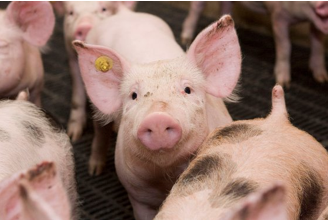There is definitely potential for the development of a Precision Livestock Farming (PLF) tool for the early detection of ear biting in pigs.
开发一种用于早期检测猪耳咬伤的精确畜牧业(PLF)工具无疑很有潜力。
That became clear after ground breaking work from a team of Irish and Belgian researchers, whose paper was recently published in the peer-reviewed journal Applied Animal Behaviour Science. The scientists were connected to the Irish research institute Teagasc and to KU Leuven in Belgium.
这一点在爱尔兰和比利时的一个研究小组进行了突破性的工作后变得清晰起来,他们的论文最近发表在同行评议的期刊《应用动物行为科学》(Applied Animal behavior Science)上。这些科学家们与爱尔兰研究机构Teagasc和比利时的KU Leuven有一定关系。
Pigs having difficulty with the farm environment
生猪难以适应猪场环境
In their abstract, the researchers wrote that behaviours such as tail and ear biting can occur in intensive farms as the animals have difficulty coping with the environment and their inability to perform natural behaviours. However, much less is known about the aetiology of ear biting behaviour compared to tail biting behaviour.
在摘要中,研究人员写道,因为生猪很难适应环境,也无法发挥天性,在集约化猪场中,会发生咬尾巴和咬耳朵这样的行为。然而,与咬尾行为相比,人们对咬耳行为的病因学知之甚少。

A pig with virtually untouched ears. This animal was not part of the research described in this article. Photo: Jan Sibon
一头耳朵几乎完好的猪。图片与本文所述研究无关。图:Jan Sibon
Application of new intervention strategies may be the key to deal with this welfare issue. The discipline of Precision Livestock Farming (PLF) allows farmers to improve their management practices with the use of advanced technologies, the researchers wrote. “Exploring the behaviour is the first step to identify reliable indicators for the development of such a tool.”
运用新的干预策略可能是解决这一福利问题的关键。研究人员写道,精准畜牧业(PLF)允许农民使用先进的技术来改进他们的管理实践。“研究这种行为是为开发这种工具确定可靠指标的第一步。”
An ethogram of biting and bitten pigs
施咬和被咬猪的行为谱
Therefore, the scientists aimed to develop an ethogram of biter and bitten pigs during an ear biting event. An ethogram is a catalogue or inventory of behaviours or actions exhibited by an animal used in ethology. On top of that, they aimed to find potential features for the development of a tool that can monitor ear biting events automatically and continuously. The observational study was carried out on a 300 sow farrow-to-finish commercial farm in Ireland (Co. Cork) during the 1st and 2ndweaner stages.
因此,科学家们的目标是开发一种在咬耳事件中施咬和被咬猪的行为谱。行为谱是动物行为学中所使用的对动物行为进行记录的目录。除此之外,为了开发一种能够自动连续监测咬耳事件的工具,他们的目标是寻找所需的功能。该观察性研究是针对爱尔兰一个300头母猪的商业农场(Co. Cork)在第1和第2断奶阶段进行的。
The team video recorded in total 3 pens per stage, holding about 35 pigs each, 6 pens in total. They selected 2.2 hours of videos per pen for video analysis. In addition, they developed 2 ethograms, one for the biter and one for the bitten pig, to describe their behavioural repertoire.
该团队录像每阶段记录3个猪舍,每个猪舍里约35头猪,共6个猪舍。他们从每个猪舍中选取2.2小时的视频片段进行分析。此外,他们还开发了两种行为谱,一种用于施咬的猪,另一种用于被咬的猪,以描述它们的行为。
Pig biter behaviour identified
施咬方行为鉴定
For the video data, duration and frequency of the observed behavioural interactions were quantified. The research team identified 6 behaviours for the biter pig and a total of 710 interactions were observed:
视频数据对观察到的行为交互的持续时间和频率进行了量化。研究小组鉴定了施咬猪的6种行为,共观察到710种相互作用:
• Chewing (215 cases);
• Quick bite (138 cases);
• Pulling ear (97 cases);
• Shaking head (11 cases);
• Gentle manipulation (129 cases); and
• Attempt to ear biting (93 cases).
• When the behaviour observed was not certain, it was classified as doubt (27 cases).
•咀嚼(215例);
•快速咬伤(138例);
•拔耳(97例);
•摇头(11例);
•轻咬(129例);
•尝试咬耳(93例)。
•当观察到的行为不确定时,归类为存疑(27例)。
Bitten pig behaviour identified
被咬猪行为鉴定
In total 7 behaviours were identified for the bitten pig in response to the biters’ behaviour and were divided in 4 non-vocal behaviours described as:
根据被咬猪的行为,总共确定了被咬猪的7种行为,并将其分为4种非发声行为,描述如下:
• Biting (40 cases);
• Head knocking (209 cases);
• Shaking/moving head (225 cases); or
• Moving away (156 cases).
In addition, the researchers identified 3 vocal behaviours as
• Scream (74 cases);
• Grunt (166 cases); and
• Squeal (125 cases).
•咬伤(40例);
•头部撞击(209例);
•摇头 (225例);
•撤离(156例)。
此外,研究人员还发现了三种发声行为
•尖叫(74例);
•咕哝(166例);
•悲鸣(125例)。
The team classified vocal behaviours using a verified set of features yielding a precision of 83.2%. The scientists found a significant difference in duration between all the behaviours, except between gentle manipulation and chewing where they found no difference in duration.
研究小组使用一组经过验证的特征对声音行为进行分类,准确率为83.2%。科学家们发现,所有这些行为的持续时间都有显著差异,除了轻咬和咀嚼之间没有发现持续时间的差异。
Heterogeneity of ear biting behaviours
咬耳行为的异质性
The results illustrate the heterogeneity of ear biting behaviours, which may be used to better understand this poorly studied damaging behaviour. They also indicate potential for the development of a PLF tool to automatically, continuously monitor such behaviour on farm by combining the behaviour of the biter pig and the bitten pigs’ responses.
研究结果说明了咬耳行为的异质性,可能有助于更好地理解这个研究较少的损伤行为。他们还指出,有可能开发一种PLF工具,结合施咬猪的行为和被咬猪的反应,自动、持续地监测猪场中的这种行为。
The scientific article was authored by Alessia Diana and Laura Ann Boyle, Teagasc, Ireland; Lenn Carpentier, Daniel Berckmans, Deborah Piette and Tomas Norton, KU Leuven, Belgium. Ms Diana is also connected to University College Dublin, Ireland.
这篇科学论文的作者是爱尔兰Teagasc的Alessia Diana和Laura Ann Boyle;比利时KU Leuven的Lenn Carpentier、Daniel Berckmans,、Deborah Piette和Tomas Norton。戴安娜女士还与爱尔兰国立大学都柏林大学学院有联系。
原文链接
(文/爱猪网记者刘坤颖编译,爱猪网原创,转载请注明出处)










